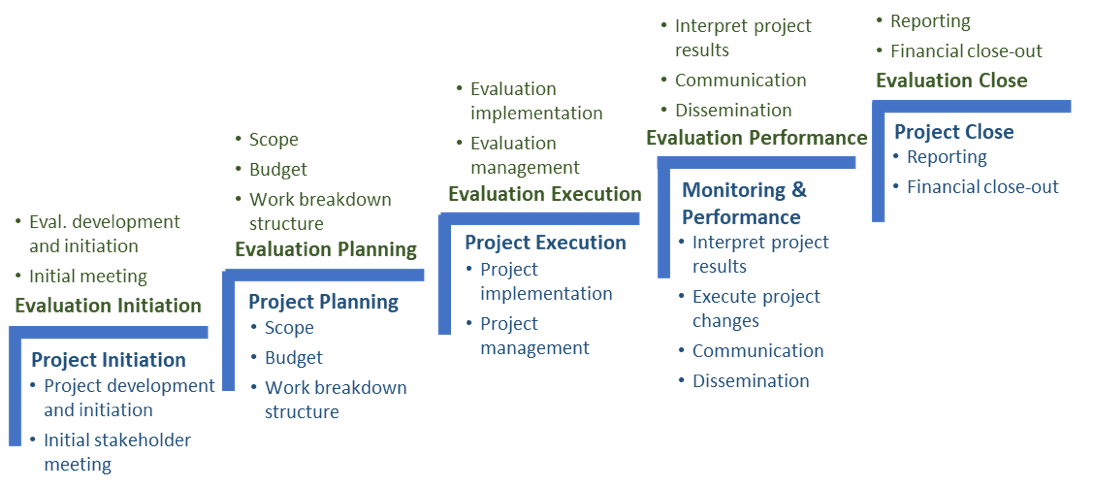We’re Robin Taylor (RTRES Consulting), Erin Burr (ORAU), and Ann Martin (ORAU) and over the years our evaluation work has focused on STEM education and workforce development programs. Each of us have familiarity with project management (PM) and have worked on numerous projects that have required adjustment of our evaluation approaches, PM styles, and the availability of PM tools we can use. Throughout our careers in evaluation, we have noted a parallelism in the five PM process groups outlined in the Project Management Body of Knowledge (PMBOK Guide) and the phases for conducting and completing evaluation. The figure shows the five process groups of PM and shows the parallelism of evaluation activities for each process. It is important to remember that while there is a natural sequence to processes, there is also an iterative interaction among processes.
Hot Tip: The Project Management Institute offers a number of certifications in PM, but even if you don’t want a certification, invest in resources such as the PMBOK Guide book to help gain an understanding of PM. The learning you receive can support your growth and increase your skillsets as an evaluator.
Rad Resources: A plethora of tools and software exist to support document management (e.g., Dropbox, Google Drive, Office 365) and project management (asana, trello, wrike). Find the resources that meet your needs and continually share what you learn with others.
Lesson Learned: Leveraging the tools and approaches you utilize or select for PM, including documents and resources you create for PM purposes, can add value to the evaluation and to the projects/programs you evaluate. For instance:
- Use the records from PM tools and conversations as sources of evaluation data.
- Utilize evaluation plans, communication plans, and data management plans to benefit the project.
- Leverage features of PM tools, like user access, documentation, and collaboration tools.
- Share project management products with project team.
- Demonstrate record-keeping and data storage compliance across multiple sites and funders.
The American Evaluation Association is celebrating STEM Education and Training TIG Week with our colleagues in the STEM Education and Training Topical Interest Group. The contributions all this week to aea365 come from our STEM TIG members. Do you have questions, concerns, kudos, or content to extend this aea365 contribution? Please add them in the comments section for this post on the aea365 webpage so that we may enrich our community of practice. Would you like to submit an aea365 Tip? Please send a note of interest to aea365@eval.org. aea365 is sponsored by the American Evaluation Association and provides a Tip-a-Day by and for evaluators.


I’d like to thank-you very much for your contribution to the American Evaluation Association- Tip a Day. As someone who is currently in the throes of completing my first course in evaluation inquiry, I’m only beginning to have my eyes opened to this fascinating and complex field of study. I’m intrigued with the parallels you drew between evaluation and project management. It caused me to question what else might evaluation and business share and what can we learn?
Small, precariously funded social programs are incessantly forced to prove their value through a formal evaluation process, but often are confronted with inadequate financial and human resources to address this demand. I wonder if small business, with an eye to efficiency for project management, can offer suggestions for this dilemma. Essentially, is there room for the development of an evaluation process that is scaled down, expedient, cost-effective and yet maintains integrity and commitment to standards of practice? Could this be integrated into smaller programs as an ongoing component?
In considering the parallels you’ve raised in evaluation and project management, it begs consideration of whether there are other similarities that exist in additional fields. Is this a consideration in evaluation, particularly if using the participatory approach? Surely it would be beneficial to share a familiar vocabulary with all stakeholders. In addition, I wonder if it would positively contribute to the probability of evaluation results use? Any thoughts would be greatly appreciated.
I would like to thank-you again for an article that provided not only valuable practical tips but inspired contemplation as well.